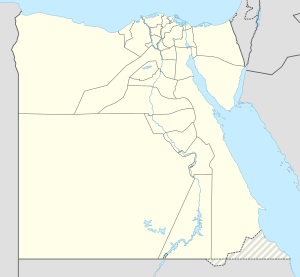مندس
مندس
Mendes | |
|---|---|
 | |
| الإحداثيات: 30°57′30″N 31°30′57″E / 30.95833°N 31.51583°E | |
| البلد | |
| محافظة | محافظة الدقهلية |
| المركز | تمى الأمديد |
| منطقة التوقيت | UTC+2 (EST) |
| • الصيف (التوقيت الصيفي) | +3 |
مندس Mendes، هي مدينة في مصر القديمة، وهي كلمة يونانية مختصرة، وكانت تنطق بالمصرية القديمة "بي-بندد P-bended" ذلك الموقع المصري الكبير الذي يعني: بيت الكبش رب جديت Djedit، وهو اليوم موقع تل الربع. ويتطابق ذات الاسم مع اسم القرية المصرية المعروفة حاليا "بتمى الأمديد"، الدقهلية، وهي مدينة تقع في شرق الدلتا وتقع على فرع ثانوي للنيل.[1]
تاريخ
|
ولقد قامت مدينة "جديت" خلال الدولة القديمة وكان ربها المقدس يتجسد في هيئة الكبش (وفي العصور الحديثة تجسد في هيئة الجدي). وكان هذا الكبش يعتبر أحد مظاهر الإله رع والإله أوزيريس منذ الدولة الوسطى. وبعد ذلك كان تجسيدا للآلهة الأربعة الأولية :(رع كرمز للنار، وشو كرمز للهواء، وجب كرمز للأرض، وأوزيريس كرمز للماء). وكان الكبش يوصف بأنه المحرك الأساسي للتوالد والتناسل الحيواني، فهو الذكر الذي يغطي الإناث. وبالرغم من أن هذا الدور الذي يقوم به هذا الإله المحلي كان يحتل مكانا محدودا صغيرا في المجمع الإلهي الملكي (وكان رمسيس الثاني يتفاخر بأنه من نسل هذا الإله).
الحكم
الأسرة المندسية
كانت الأسر التاسعة والعشرون المندسية. وليدة عملية هجوم قوية، فقد قام "أميرتايوس" الصاوي، والذي يعد بمفرده مؤسسا للأسرة الثامنة والعشرين، بطرد جحافل الجيوش الفارسية من معظم الأراضي المصرية. ثم قام بعده شخص يدعى "نفريتس" من مدينة "مندس" (398 - 392 ق.م.) بخلعه عن العرش، وأكمل هو مسيرة التحرير. جاء بعد ذلك هكر (هاكوريس) ومعنى اسمه "الذي يجدد التيجان" وتصارع على العرش مع "بي ساموت أو بساموتيس"، وانتهى الصراع بانتصار الأخير وأعلن نفسه بأنه هو الذي اختاره الكبش سيد مندس. ثم تلاه على العرش نفريتس الثاني الذي قام القائد "نختانبو" من مدينة سمنود (عام 378 ق.م.) بخلعه هو الآخر. ولا شك أن اعتلاء هذا القائد للعرش والاضطرابات التي سادت البلاد وسقوط المندسبين كانت كلها علامات تعبر عن الطموح الجامح الذي كان يجتاح كبار العسكريين، والذين كانوا يسيطرون على المدن الرئيسية بالدلتا بعد طرد الفرس مباشرة. وبعد هاكوريس (390 - 373 ق.م.) من أكثر ملوك هذه الأسرة صيتا وشهرة، بسبب مقصورة صغيرة في الكرنك اغتصبها من "بساموتيس"، والتي ترك جنوده القراصة المرتزقة توقيعاتهم على جدرانها. وكان هاكوريس يستأجر الجنود الإغريق ضمن جيشه، ويعقد تحالفات مع المدن اليونانية ومع البيسيديين، كما تدخل لمساعدة السلامين في فينيقيا. وبذلك نجد أن سياسة هاكوريس الخارجية التي كانت تهدف إلى حماية البلاد من خطر هجمات الفرس عليها مرة أخرى، لا تختلف كثيرا عن سياسة الأسرة السمنودية.
الآثار
The site is today the largest surviving tell in the Nile delta, and consists of both Tell El-Ruba (the site of the main temple enclosure) and Tell El-Timai (the settlement site of Thmuis to the south). Overall, Mendes is about 3 km long from north to south and averages about 900m east-to-west. An Old Kingdom necropolis is estimated to contain over 9,000 interments. Several campaigns of 20th-century excavations have been led by North American institutions, including New York University and the University of Toronto, as well as a Pennsylvania State University team led by Donald Redford. Under the direction of Redford, the current excavations are concentrating on a number of areas in and around the main temple.
Work on the New Kingdom processional-style temple has recently uncovered foundation deposits of Merenptah below the second pylon. It is thought that four separate pylons or gates existed for each of the Avatars of the main deity worshiped here. Evidence has suggested that their construction dates from at least the Middle Kingdom, as foundation deposits were uncovered. The original structures were buried, added to, or incorporated into later ones over time by later rulers.
A cemetery of sacred rams was discovered in the northwest corner of Tell El-Ruba. Monuments bearing the names of Ramesses II, Merneptah, and Ramesses III were also found. A temple attested by its foundation deposits was built by Amasis II. The tomb of Nepherites I, which Donald Redford concluded was destroyed by the Persians,[2] was discovered by a joint team from the University of Washington and the University of Toronto in 1992–1993.
On the edge of the temple mound, a sondage supervised by Matthew J. Adams has revealed uninterrupted stratification from the Middle Kingdom down to the First Dynasty. Coring results suggest that future excavations in that sondage should expect to take the stratification down into the Buto-Maadi Period. The material excavated so far is already the longest uninterrupted stratification for all of the Nile Delta, and possibly for all of Egypt.[3]
الهوامش
- ^ پاسكال ڤيرنوس (1999). موسوعة الفراعنة. دار الفكر.
{{cite book}}: Unknown parameter|coauthors=ignored (|author=suggested) (help) - ^ Redford, Donald B. (2004). Excavations at Mendes. Brill. p. 34. ISBN 978-90-04-13674-8.
- ^ Adams, Matthew J. (2009). "An Interim Report on the Naqada III – First Intermediate Period Stratification at Mendes". Delta Reports (1): 121–206. ISBN 9781842172445.
المصادر
- Redford, Donald Bruce. 2001. "Mendes". In The Oxford Encyclopedia of Ancient Egypt, edited by Donald Bruce Redford. Vol. 2 of 3 vols. Oxford, New York, and Cairo: Oxford University Press and The American University in Cairo Press. 376-377.
- ———. 2004. Excavations at Mendes. Volume 1: The Royal Necropolis. Culture and History of the Ancient Near East 20. Leiden, Boston, Köln: Brill. ISBN 90-04-13674-6
- ———. 2005. "Mendes: City of the Ram God." Egyptian Archaeology: The Bulletin of the Egyptian Exploration Society 26:8-12.
- Baines & Malek 2000: Cultural Atlas of Ancient Egypt, Checkmarks Books. ISBN 0-8160-4036-2
- This article incorporates text from the public domain Dictionary of Greek and Roman Geography by William Smith (1856).
- http://www.personal.psu.edu/users/d/b/dbr3/mendes.html
- Adams, Matthew J. 2009. “An Interim Report on the Naqada III – First Intermediate Period Stratification at Mendes,” Delta Reports 1 (2009) 121–206.

